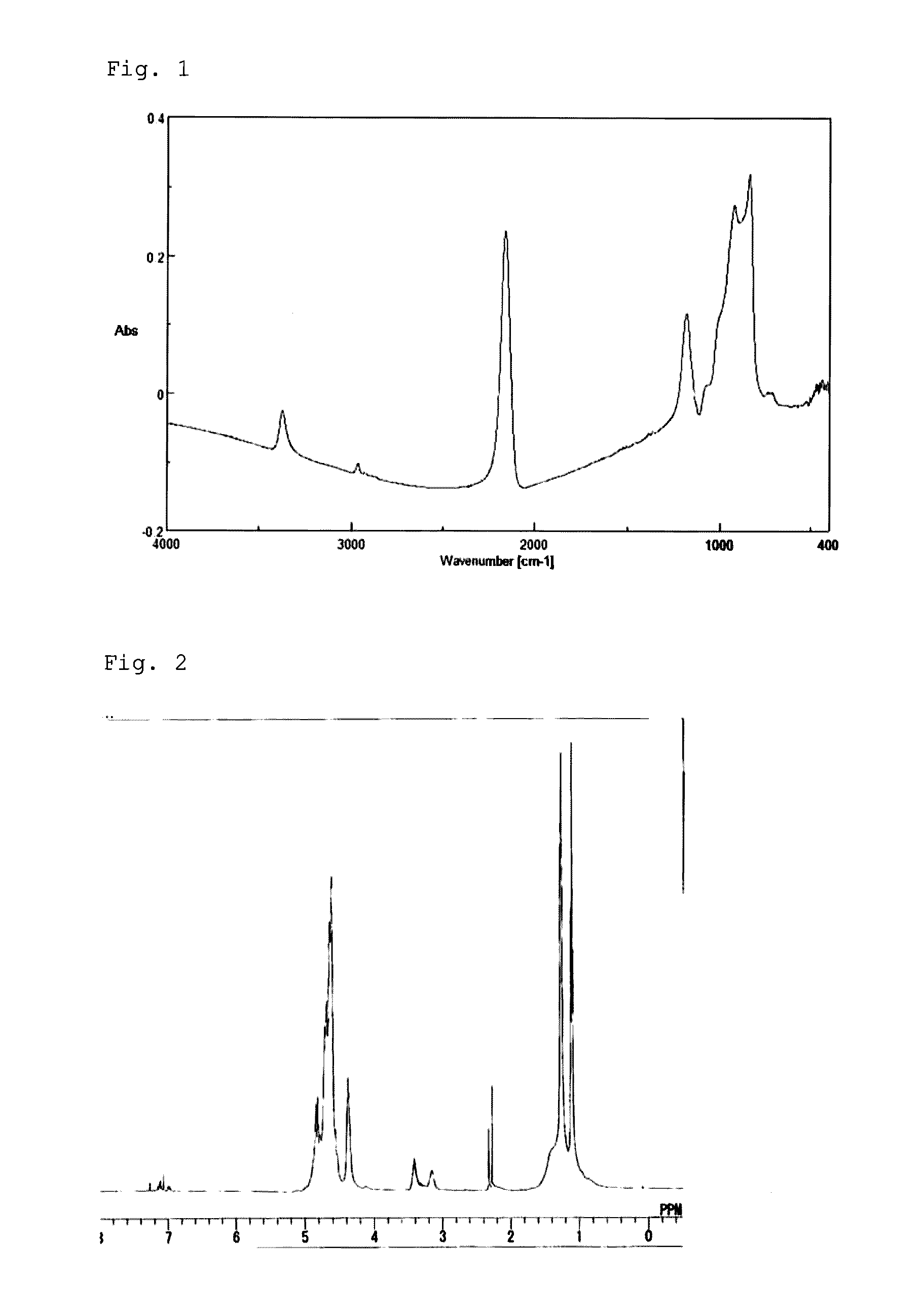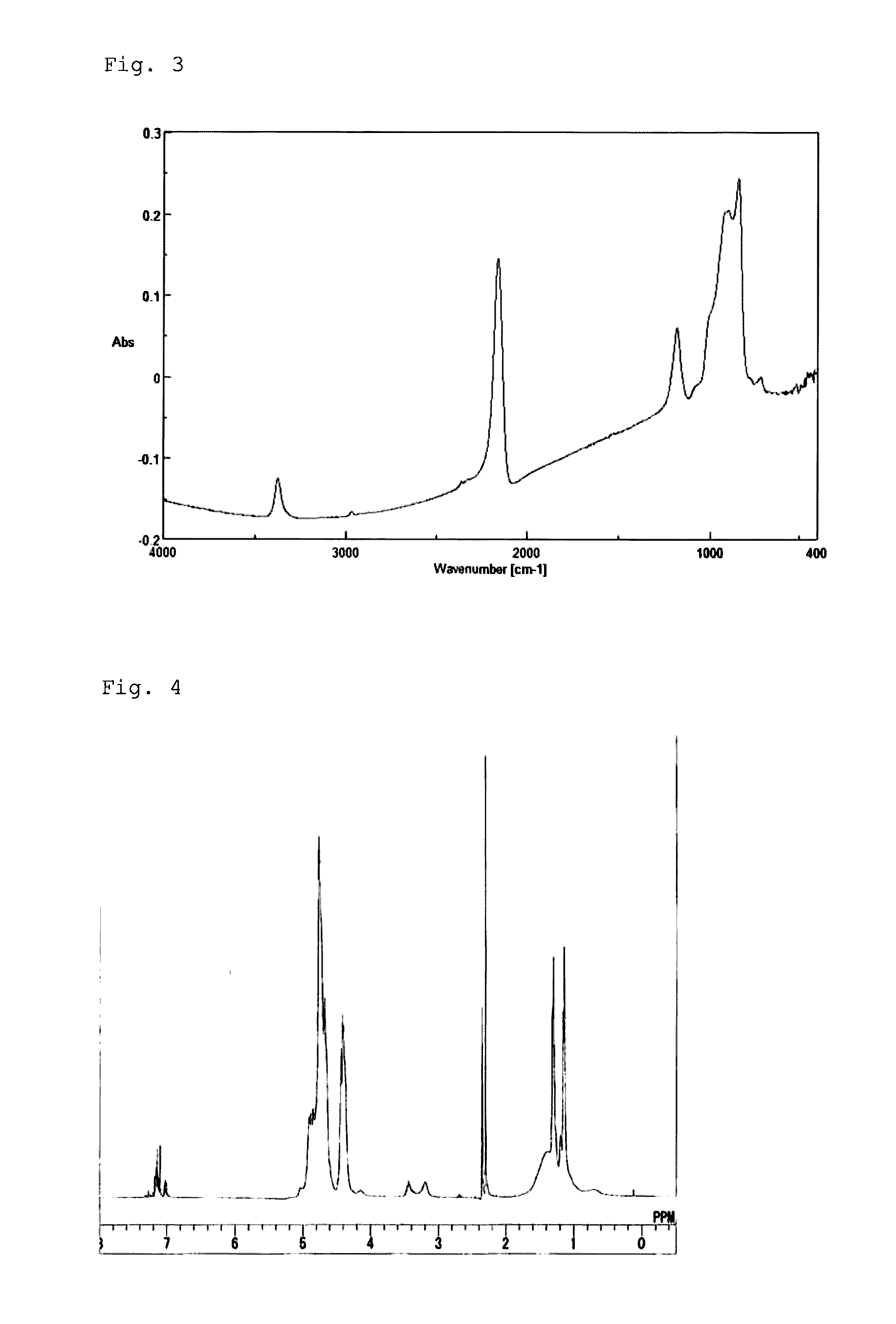Copolymerized polysilazane, manufacturing method therefor, composition comprising same, and method for forming siliceous film using same
a technology of copolymerized polysilazane and copolymerization, which is applied in the direction of silicon oxides, silicon compounds, coatings, etc., can solve the problem of inability to obtain achieve excellent solvent resistance properties, high withstand voltage characteristics, and satisfactory voltage resistance characteristics
- Summary
- Abstract
- Description
- Claims
- Application Information
AI Technical Summary
Benefits of technology
Problems solved by technology
Method used
Image
Examples
example 1
[0063]After the inside of the reactor was substituted by dry nitrogen gas, 40 g of dehydrated pyridine and 460 g of dehydrated xylene were put into the reactor and then cooled down to 0° C. or lower, followed by addition of 25 g of dichlorosilane (DCS) thereto. After the mixture solution was stirred for one and a half hours, 44 g of isopropylamine was put into the solution and aminolysis was performed at a reaction temperature of −5 to 15° C. for 100 minutes. Subsequently, NH3 was injected into the solution at an injection rate of 250 ml / minute for 4.4 minutes, followed by stirring for 100 minutes while maintaining the temperature at −5 to 15° C. After filtration, the filtrate obtained was mixed with xylene, heated to 40° C., and distilled under a reduced pressure of 5 mmHg to remove pyridine. As a result, a solution (Solution A) having a concentration of 20 weight-%, which contains a resin (Resin A) having a weight average molecular weight (Mw) of 1,700, was obtained. By the FT-IR ...
example 2
[0064]After the inside of the reactor was substituted by dry nitrogen gas, 40 g of dehydrated pyridine and 456 g of dehydrated xylene were put into the reactor and then cooled down to 0° C. or lower, followed by addition of 25 g of dichlorosilane (DCS) thereto. After stirring of the mixture solution for one and a half hours, 29 g of isopropylamine was put into the solution and aminolysis was performed at a reaction temperature of −5 to 15° C. for 100 minutes. Subsequently, NH3 was injected into the solution at an injection rate of 250 ml / minute for 26.8 minutes, followed by stirring for 100 minutes while maintaining the temperature at −5 to 15° C. After filtration, the filtrate obtained was mixed with xylene, heated to 40° C., and distilled under a reduced pressure of 5 mmHg to remove pyridine. As a result, a solution (Solution B) having a concentration of 20 weight-%, which contains a resin (Resin B) having a weight average molecular weight (Mw) of 1,350, was obtained. The FT-IR sp...
example 3
[0065]After the inside of the reactor was substituted by dry nitrogen gas, 41 g of dehydrated pyridine and 456 g of dehydrated xylene were put into the reactor and then cooled down to 0° C. or lower, followed by addition of 26 g of dichlorosilane (DCS) thereto. After stirring of the mixture solution for one and a half hours, 7.8 g of isopropylamine was put into the solution and aminolysis was performed at a reaction temperature of −5 to 15° C. for 100 minutes. Subsequently, NH3 was injected into the solution at an injection rate of 250 ml / minute for 62.4 minutes, followed by stirring for 100 minutes while maintaining the temperature at −5 to 15° C. After filtration, the filtrate obtained was mixed with xylene, heated to 40° C., and distilled under a reduced pressure of 5 mmHg to remove pyridine. As a result, a solution (Solution C) having a concentration of 20 weight-%, which contains a resin (Resin C) having a weight average molecular weight (Mw) of 1,950, was obtained. The FT-IR s...
PUM
| Property | Measurement | Unit |
|---|---|---|
| molar ratio | aaaaa | aaaaa |
| molar ratio | aaaaa | aaaaa |
| temperature | aaaaa | aaaaa |
Abstract
Description
Claims
Application Information
 Login to View More
Login to View More - R&D
- Intellectual Property
- Life Sciences
- Materials
- Tech Scout
- Unparalleled Data Quality
- Higher Quality Content
- 60% Fewer Hallucinations
Browse by: Latest US Patents, China's latest patents, Technical Efficacy Thesaurus, Application Domain, Technology Topic, Popular Technical Reports.
© 2025 PatSnap. All rights reserved.Legal|Privacy policy|Modern Slavery Act Transparency Statement|Sitemap|About US| Contact US: help@patsnap.com



